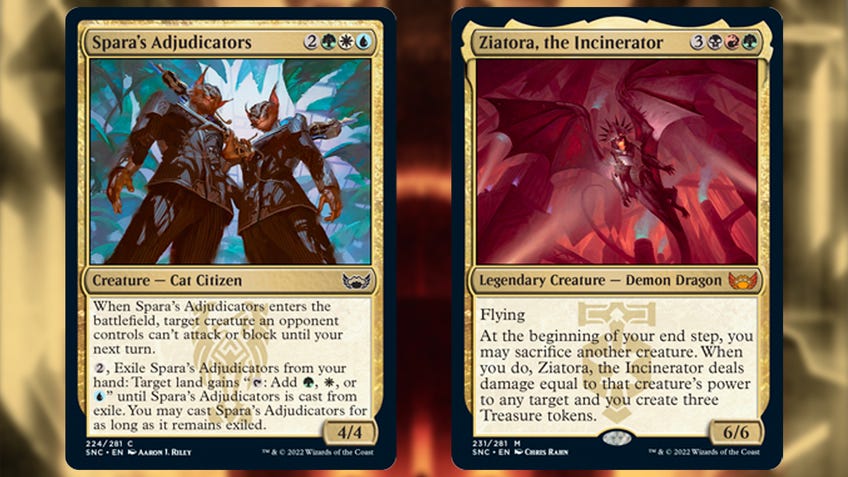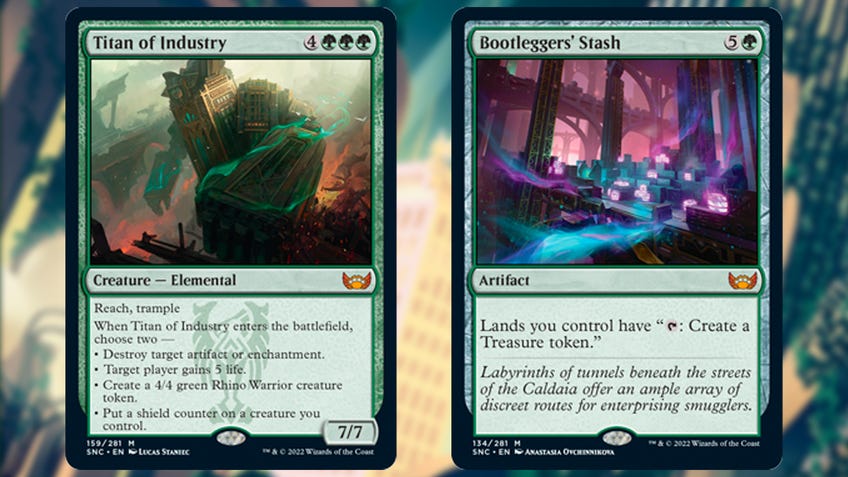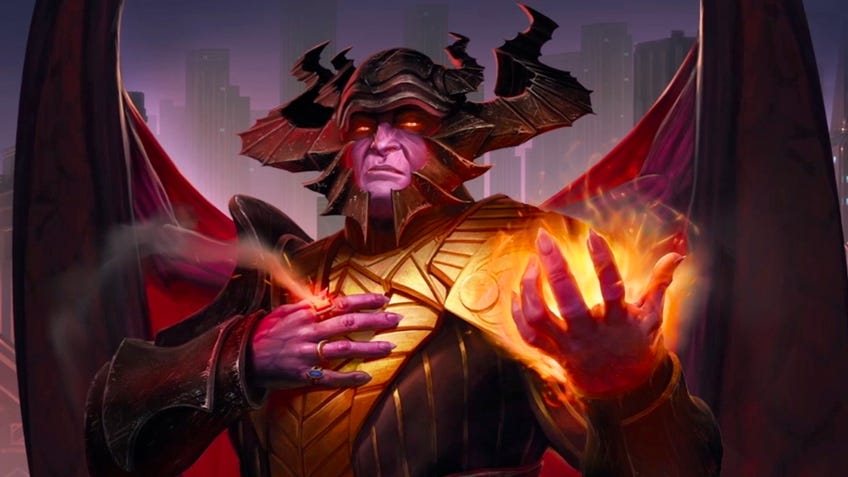Streets of New Capenna brings the messiness of the mob to Magic: The Gathering’s latest set
Crime doesn’t play.
Magic: The Gathering’s second major set of the year, New Capenna, is here, taking the classic fantasy card game into a world of gangs and mobs. It’s the second Standard-legal set of 2022 and, with such a unique setting, a lot of people are quite excited to see how well mobsters will translate into MTG. After all, we normally see either fantasy settings or futuristic ones, whereas the ideas of New Capenna feel decidedly more modern-day.
That’s not all. The set also sees the game going back to tri-colour combinations thanks to the leaders of the plane’s crime families, which each represent a different set of three. This means the first impression of New Capenna is of a set that wants to let players mess about with more colours again.
The best example of this has to be the new tri-land cycle, which allows players to pick lands that offer three different colours. Not only that, but unique fetch lands have been introduced. These get sacrificed the moment they come into play to fetch one of three different basic land types and grant you one life.
There’s also a cycle of creature cards, such as Spara’s Adjudicators, that can be exiled from your hand to grant a land the ability to tap for three colours of mana. It’s very clear that the aim of New Capenna is to have us all messing about with these colour combinations. In terms of tools, it’s done quite well. It makes the Draft and Sealed formats feel fun because you’re allowed to experiment with a lot of different cards, provided you get the correct mana fixing.
This focus on three colours has a downside, and it’s one that players who’ve been around for a while will be familiar with; this set feels as though it was made for Commander players. This was probably inevitable when focusing on having groups of three colours, but it doesn’t change the fact that you’ve got cards such as Ziatora, the Incinerator, which doesn’t feel viable outside of Commander.
New Capenna has incredibly fun mythic rare cards, but constructed Magic: The Gathering decks aren’t likely to use them.
Ziatora is a great card. It costs six mana; is Black, Red and Green; and reads, “At the beginning of your end step, you may sacrifice another creature. When you do, Ziatora, the Incinerator deals damage equal to that creature’s power to any target and you create three Treasure tokens.” That’s a cool effect, but only really in Commander. This applies to most of the mythic rare cards in the set - including Lord Xander, the Collector, who has a list of abilities that can target different players and costs seven mana. (Xander made an appearance in our list of the best New Capenna cards.) These are incredibly fun cards for sure, but constructed Magic: The Gathering decks aren’t likely to use them. That’s really the biggest criticism of the set - but if you can ignore that, you’re in for a good time.

In terms of new mechanics, New Capenna is stacked. We’ve got Hideaway, Connive, Casualty, Blitz, Alliance and shield counters, which feels like a lot of stuff to remember. Hideaway is actually a returning mechanic from 2007’s Lorwyn set, allowing you to exile a card from near the top of your library and then play it for free if you can meet a specific requirement.
Connive creatures let you draw a card and then discard a card, which is always good, but then gives them a +1/+1 counter for each nonland card discarded. This feels pretty powerful all around. Drawing cards and filtering through your deck for specific things you’re looking for is great, and having the chance to make your creatures bigger at the same time is amazing.
Casualty allows you to sacrifice creatures to copy spells, which is going to be an interesting one to play with. This ability should allow for creatures that have lost efficacy, like early game plays that can only serve as chump blockers, to find new usefulness. Hooray.
Blitz reads, “If you cast this spell for its blitz cost, it gains haste and ‘When this creature dies, draw a card.’ Sacrifice it at the beginning of the next end step.” In essence, you get to put the creature into play for a single attack, and then it replaces itself by allowing you to draw a card. It feels similar to mechanics we’ve seen before, like Dash, but the extra card at the end of it is a nice touch.
Alliance is a mechanic that benefits people who like to play with a lot of creatures. It triggers when another creature enters the battlefield under your control, and can have an array of different effects, from gaining you life to creating treasure tokens. It’s a potentially powerful ability, but likely to draw attention in any format with removal… which is every format.
The final mechanic is shield counters. These are special counters that basically give a creature a ‘Get out of Graveyard Free’ card. It stops them being destroyed by either damage or a spell that would destroy them; instead, you remove the counter when that happens. This one is hard to rate, but it feels pretty powerful, especially as you can use a card like Boon of Safety to put a shield counter on something at instant speed.
For those of us who’ve been playing MTG for a while, it’s nice to have so many toys to build around.
The sheer breadth of New Capenna’s mechanics is going to make things tougher for newer MTG players to grasp, but for those of us who’ve been playing for a while, it’s kind of nice to have so many toys to potentially build around. The mechanics feel very correct for the colour combinations they’re attached to - we’re not breaking any ground with colour identity here. Well, except for Green, which has two cards that don’t fit at all.

Colour identity, for those who’ve not heard the term before, is what defines MTG’s mana colours in gameplay. Green, for example, often has big creatures, struggles against flying things, is anti-artifact much of the time, has a lot of lands and is about all things natural… which is why it’s incredibly weird to see a New Capenna card called Titan of Industry in Green.
In terms of what Titan of Industry does, however, it fits. It’s a giant 7/7 for seven mana that can destroy artifacts or enchantments, gain life, create rhino tokens, or put a shield counter on something. It even has both reach and trample, which makes it very powerful. However, industry is just about the most un-Green thing we can think of. Capitalism isn’t the natural state of things, and it’s really weird to see it here.
The other card that doesn’t fit is Bootleggers’ Stash, a six-mana artifact that gives lands you control the ability to create treasure tokens. Green has had artifacts before, but one that helps you create yet more artifacts is odd. While Green has dabbled in treasure, it’s typically more of a Blue, Red and Black thing than a Green one.
While these two New Capenna cards breaking the colour identity of Green isn’t the end of the world, it does mean that two of the Green mythics don’t feel right.
New Capenna is an excellent set in both Draft and Sealed because the mana fixing is good, you feel like you can experiment with whatever cards you end up with and there are clear directions to build in. All of this makes it good for these limited formats, but when it comes to constructed formats like Standard or Modern, it’s hard to see many of the multi-coloured cards taking off. Some will, for sure, but far too many of them feel like they’re just great Commander fodder.
This is an issue we had with Neon Dynasty earlier this year, too. Most Magic: The Gathering sets have a few cards for Commander, sure, but it shouldn’t feel like the focus. New Capenna doesn’t feel like that. It feels as though Wizards of the Coast is slipping into old habits and rewarding us Commander fanatics once again.
New Capenna also continues the game’s recent trend of putting a light novel’s worth of text on the front of every card. Magic: The Gathering is a game that a lot of people would already describe as being complicated - and the more the game continues to follow this trend, the more that’s going to be the case.
New Capenna feels like another step in a new direction for Magic: The Gathering as a whole, but too many changes often lead to a messy and chaotic result.
Streets of New Capenna will likely bring a smile to your face. The flavour of the set’s gangs is really strong, there’s a clear sense of identity to the plane, and it has gameplay mechanics that are interesting and thought-provoking. The pros are high, the cons are low.
New Capenna almost feels like another step in a new direction for Magic: The Gathering as a whole, but too many changes often lead to a messy and chaotic result. Whatever transitional phase the TCG is in at the moment, New Capenna feels like its epitome.




